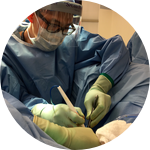About This Project
Molecular pathoepidemiology is the study of the cause and natural history of disease on a molecular, individual, and population level, utilizing tissue specimens and data from existing epidemiological studies. We aim to use this method to better diagnose bladder cancer, to more accurately estimate its risk of recurrence, and to inform personalized targeting of anti-cancer drugs. In the long term, we plan to apply these principles to other cancers and related illnesses.
Ask the Scientists
Join The DiscussionWhat is the context of this research?
Bladder urothelial carcinoma, the #1 cancer associated with smoking, affects over 400,000 new patients every year. Bladder cancer is not a single illness, but rather a heterogeneous group of tumors with unique genetic signatures and natural histories. This makes it an ideal disease to study using personalized medicine and molecular pathoepidemiology.
Last year, in a peer-reviewed article in the American Journal of Men's Health, I put forth the theoretical framework for using personalized medicine and pathology to diagnose and treat illnesses such as bladder cancer. It is this framework that will guide our proposed study of bladder cancer biomarkers.
What is the significance of this project?
Over 150,000 people die of bladder cancer every year despite treatment with chemo, radiotherapy, and surgery. This makes us believe that there must be a better way to fight it. With this project, we aim to better understand bladder cancer at all levels: diagnosis, risk stratification, therapy, and recurrence.
Can we do it? You bet. We have the publication track record to prove it:
What are the goals of the project?
One of the toughest problems faced by pathologists is differentiating between urothelial carcinoma in situ and "shoulders" of papillary lesions - two fundamentally different kinds of cancers. Doctors currently differentiate between these by using a battery of tests that don’t work as well as they would like. We're going to use a special staining method, immunohistochemistry, to try to distinguish between these lesions under the microscope by looking at "microtubule destabilizing" proteins in the cells. We aim to develop and validate antibodies against these proteins as diagnostic tests. And we're going to do it right, by closely following the latest guidelines for diagnostic test reporting.
Budget
We are outfitting a new Internet-connected work room to serve our local and distant team members. To this end, out of our own pockets, we have already spent:
$1,933.09 - computers
$557.96 - monitors
$341.67 - support services
$106.24 - encryption software
We are good stewards of our resources. To keep costs down, we go open-source when we can, and currently use:
$0 - R Project for Statistical Computing Software
$0 - PSPP Statistical Analysis Software
$0 - TeamViewer 11 Personal Edition
For our next investment, we asked ourselves, what would be the biggest game changers in terms of increasing our efficiency? The answers were obvious. First, Internet-connected digital microscopy equipment would provide us with new capabilities. Second, subscriptions to Internet-based encrypted cloud storage and image-editing software would enhance our ability to collaborate.
Therefore, we request your help with purchasing a digital trinocular pathology microscope, DropBox Pro, and Adobe Creative Cloud.
Endorsed by
Meet the Team
Team Bio
Help us subvert the science status quo! We are building a team of the best and brightest trainees around - resident physicians, graduate students, and medical students - to pursue projects that we are passionate about. Our group has no physical boundaries - we collaborate over the Internet. We have a proven track record and have already published work in JAMA, Journal of Surgical Oncology, and Urology, among many other venues.
Douglas A. Mata, MD, MPH
Douglas A. Mata, MD, MPH, is a clinical fellow at Harvard Medical School and a resident physician in pathology at the Brigham and Women’s Hospital in Boston. He attended Rice University and the University of Cambridge, and was a Fulbright Scholar at the European campus of the M.D. Anderson Cancer Center in Madrid, Spain. His research has appeared in JAMA, Journal of Surgical Oncology, Lancet Psychiatry, and Proceedings of the National Academy of Sciences, and his work has been featured in Newsweek, The New York Times, Time Magazine, and U.S. News & World Report. Follow him @DouglasMataMD.
Paras Minhas, BS
Paras Minhas is an MD/PhD student at Stanford University School of Medicine whose research has appeared in Lancet Psychiatry, Critical Care Medicine, EMBO, and Brain. He is an Amgen, Goldwater, Marshall, and Paul & Daisy Soros Fellow. Follow him @ParasMin.
Taylor P. Kohn, MPhil
Taylor P. Kohn, MPhil, is a medical student at Baylor College of Medicine. He attended the University of Manchester as a Fulbright Scholar. His research has appeared in Analytical Chemistry, Canadian Journal of Urology, and Journal of the American Chemical Society. Follow him @TPKohn.
Marco A. Ramos, MPhil, MSEd
Marco A. Ramos, MPhil, MSEd, is an MD/PhD student at Yale University School of Medicine. His research has appeared in Bulletin of the History of Medicine, JAMA, and Lancet Psychiatry. Follow him @MRamos_histmed.
Lakshay Jain, BS
Lakshay Jain, BS, is a medical student at Baylor College of Medicine whose research has appeared in Urology. Follow him @TheLakshayJain.
Michelle Kim MD, PhD
Michelle Kim, MD, PhD, is a resident physician in urology. In addition to being a surgeon, she is a numbers guru with a doctorate in economics from the Wharton School. Her work has appeared in JAMA Internal Medicine, Medical Care, Pharmacoepidemiology and Drug Safety, and Urology.
Rida Khan, BS
Rida Khan, BS, is a medical student at Baylor College of Medicine. Her research has appeared in JAMA and JAMA Psychiatry. Follow her @Rida14.
Additional Information
How do we know that our project is feasible? We know it because we have already completed a successful pilot study under the mentorship of our division chief in urologic pathology, the results of which have been accepted as an abstract at this year's United States and Canadian Academy of Pathology meeting in Seattle, WA.
For those of you interested in the technical details, here is the citation and the text of the abstract:
Mata, DA, et al. Stathmin1 is a sensitive and specific biomarker for high grade urothelial carcinomas. United States & Canadian Academy of Pathology Annual Meeting. 2016.
Background: Stathmin 1 (STMN1), a microtubule destabilizing protein, regulates cytoskeletal dynamics, cell cycle progression, mitosis, and cell migration, and is influenced by p53, p27, and PI3K/Akt pathway activation. STMN1 expression has been shown to be a useful diagnostic biomarker in fallopian tube intraepithelial carcinomas and squamous intraepithelial lesions of the cervix. It is unclear whether STMN1 is useful in the diagnosis of urothelial carcinoma. The goals of this study were to determine if STMN1 can be used to differentiate between (1) urothelial carcinoma in situ (CIS) and benign/reactive/denuded urothelium (BUM); (2) CIS and the “shoulder” of a papillary urothelial carcinoma (PUC); and (3) high grade and low grade PUCs.
Design: One hundred and fourteen biopsies were examined, including 46 BUMs, 25 CISs, 24 LG PUCs, and 19 HG PUCs. All cases were examined by H&E, but scored blindly for STMN1 (absent or scattered basal cells only = negative vs near full to full thickness staining = positive), p53 (wild type vs mutant), CK20 (umbrella or scattered cells = negative vs full thickness = positive), and Ki67 (low vs elevated). Standard binary classification analysis was used to compute the sensitivity and specificity of the markers. Statistical significance was defined as a two-tailed P < 0.05.
Results: Immunohistochemical results are presented in Table 1, and sensitivity and specificity for single or combined biomarkers is presented in Table 2. Based on these results, both STMN1 and p53 appear to be far superior to CK20 for bladder biopsy evaluation.
Conclusion: Although STMN1 and p53 show similar sensitivity for CIS, STMN1 appears to be more specific for CIS and the distinction of LG vs HG PUC. Neither p53 nor STMN1 is very useful for distinguishing CIS and the shoulder of a papillary lesion. In addition to being a useful diagnostic biomarker, these results suggest that STMN1 overexpression in high grade urothelial carcinomas may potentiate aberrant cell proliferation, loss of polarity, and/or migration during early tumorigenesis.
With that out of the way, we want to make a few other points. First, the equipment that we will purchase if our experiment.com campaign is successful will last a lifetime. At any one time, our group is working on one of a dozen projects, and the microscope, online storage space, and cloud-based image-editing software will contribute to all of them. In the short term, after validating our battery of immunohistochemical markers for improving the diagnosis of bladder cancer, we plan to study their associations with disease outcome and response to therapy using epidemiological cohort data to which we have access through Harvard Medical School. This really is molecular pathoepidemiology in action.
In the long term, this equipment will also be used for other studies, for example, of prostate, renal, and thyroid cancers; the development of slide-based teaching tools for medical students interested in neuro- and psychopathology; and study of histologic correlates or consequences of specific medical conditions such as hypogonadism. We have already published several articles in these spaces, and encourage you to check them out on our website. If successful, we will proudly acknowledge this experiment.com campaign in all future manuscripts to help get the word out about this great website.
Project Backers
- 28Backers
- 100%Funded
- $5,600Total Donations
- $200.00Average Donation








